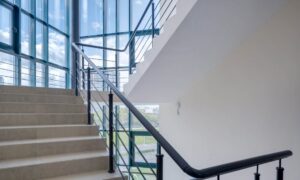In the realm of home improvement, drywall finishing and painting are critical steps that define the look and feel of a room. With advancements in techniques and materials, professionals are now equipped with an array of options to deliver superior finishes that are both durable and aesthetically pleasing. This article explores some of the most innovative methods currently transforming the industry.
The Evolution of Drywall Finishing
Drywall finishing has evolved significantly from the traditional joint taping and mud application. Today, the focus is on achieving smoother surfaces with higher resistance to wear and tear. One of the key innovations in this area is the use of lightweight joint compounds that are easier to apply and sand. These compounds expedite the drying process and reduce the labor intensity traditionally associated with drywall finishing.
High-Performance Joint Compounds
The introduction of high-performance joint compounds is a game-changer in the drywall finishing process. These compounds are formulated to shrink less, dry faster, and bond more effectively to the drywall surface. They are particularly beneficial in environments that undergo rapid temperature changes, helping to prevent cracking and seam visibility over time.
Automated Taping Tools
Automation has made its way into drywall finishing with tools that streamline the taping process. Automated taping tools dispense tape and compound simultaneously, ensuring consistent application and thickness. This not only speeds up the process but also enhances the uniformity and quality of the finish, reducing the likelihood of future repairs.
Dust Control Technologies
Sanding drywall can create a significant amount of dust, which poses health risks and makes clean-up challenging. Innovations in dust control technologies have led to the development of sanding equipment with built-in vacuum systems. These systems capture dust at the source, promoting a cleaner work environment and reducing the time spent on post-sanding cleanup.
Eco-Friendly Painting Solutions
As environmental awareness increases, so does the demand for eco-friendly painting solutions. Low VOC (volatile organic compounds) and zero VOC paints are becoming popular choices among professionals and homeowners alike. These paints reduce the emission of harmful chemicals, improving indoor air quality and offering a safer option for residential spaces.
Advanced Texture Techniques
Creating unique wall textures is an art that has benefited greatly from new tools and techniques. Professionals can now use specialized brushes, rollers, and spray equipment to achieve customized textures. These methods allow for the creation of bespoke finishes that can mimic materials like suede, marble, or even linen, adding a touch of luxury and individuality to any room.
Digital Color Matching
Choosing the right paint color is crucial, and digital color matching technology has revolutionized this process. By using a small sample, professionals can now achieve a near-perfect match with existing colors on walls or other elements. This technology ensures consistent results in touch-up jobs or when extending existing color schemes without the need for complete repaints.
The Role of Light Reflectance Values
Understanding light reflectance values (LRVs) in paint selections has become a key factor in professional painting. LRVs determine how much light a paint color reflects, which can significantly affect the perception of space and light within a room. Professionals use this knowledge to enhance small spaces or to create moods that align with a client’s aesthetic preferences.
The Impact of Paint Sheens
The choice of paint sheen can greatly influence both the aesthetics and functionality of a room. From matte to high gloss, each sheen offers distinct benefits and challenges. Matte finishes, for example, can hide imperfections but are more susceptible to damage, while high gloss is durable and easy to clean but highlights surface flaws. Professionals must balance these characteristics with the room’s purpose and lighting conditions to choose the optimal finish.
Thermal and Acoustic Insulation Techniques
Recent innovations extend beyond visual aesthetics to functional improvements in drywall installations. Techniques involving thermal and acoustic insulation are increasingly incorporated into drywall finishing. Using specially designed drywall panels and insulating compounds, professionals can enhance a home’s energy efficiency and soundproofing. This integration provides not only comfort but also long-term cost savings for homeowners.
Flexible Drywall Solutions
For rooms requiring curved walls or other unconventional shapes, flexible drywall solutions have become a viable option. These products allow for creative architectural expressions and can be finished using the same techniques as standard drywall. The ability to adapt drywall to a variety of shapes broadens design possibilities and showcases the versatility of modern drywall technology.
Enhancing Durability with Fiber Reinforced Compounds
To increase the durability of drywall finishes, professionals are now using fiber reinforced compounds. These compounds incorporate fibers that provide extra strength to the drywall surface, making it more resistant to cracks and impacts. This is particularly beneficial in high-traffic areas or in homes with children and pets, where walls are more prone to damage.
Sustainable Practices in Drywall Finishing
Sustainability is becoming a priority in the construction and renovation industry. In drywall finishing, this translates into practices such as recycling drywall waste, using materials sourced from sustainable suppliers, and employing techniques that minimize environmental impact. Professionals who adopt these practices not only contribute to environmental conservation but also meet the growing demand for green building certifications.
The Role of Lighting in Paint Selection
Lighting plays a critical role in how paint colors are perceived. Professionals often conduct thorough lighting assessments before finalizing paint Lynchburg, VA choices. This may involve testing paint samples under different lighting conditions to see how colors change throughout the day. Understanding the interplay between light and paint can prevent dissatisfaction caused by unexpected color variations in different ambient conditions.
Advanced Protective Coatings
The final step in many drywall painting projects now involves the application of advanced protective coatings. These coatings are designed to extend the life of the paint by providing resistance to UV rays, moisture, and stains. For areas exposed to harsh conditions, such as kitchens and bathrooms, these protective coatings are essential for maintaining the integrity and appearance of the wall finish.
Conclusion: Embracing Innovation for Superior Results
The field of drywall finishing and painting is continually evolving, with innovations that offer better results, faster completion times, and more environmentally friendly options. By embracing these advancements, professionals not only enhance their craft but also provide clients with high-quality, durable, and beautiful living spaces. These techniques ensure that each project not only meets but exceeds the aesthetic and functional requirements of modern interiors.
Read More From Techbullion And Businewswire.com



































